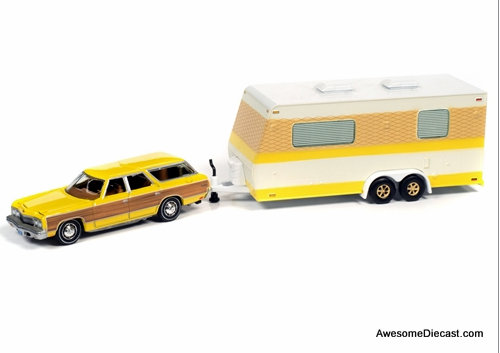Johnny Lightning
Johnny Lightning 1:64 1973 Pontiac Grand Am, Admiralty Blue
Type a description for this product here...

The Chevrolet Caprice is a full-sized automobile produced by Chevrolet in North America for the 1965 to 1996 model years. Full-size Chevrolet sales peaked in 1965 with over a million sold. It was the most popular American car in the sixties and early seventies, which, during its lifetime, included the Biscayne, Bel Air, and Impala.
Introduced in mid-1965 as a luxury trim package for the Impala four-door hardtop, Chevrolet offered a full line of Caprice models for the 1966 and subsequent model years, including a "formal hardtop" coupe and an Estate station wagon. The 1971 to 1976 models are the largest Chevrolets ever built. The downsized 1977 and restyled 1991 models were awarded Motor Trend Car of the Year. Production ended in 1996.
The Caprice name was coined by Bob Lund (Chevrolet's General Sales Manager) after a classy restaurant he frequented in New York City. Some say the car was named after Caprice Chapman, daughter of auto executive and influential Indy-car official James P. Chapman.
A Caprice Custom Sedan option package (RPO Z18) was offered on the 1965 Chevrolet Impala 4-door hardtop, adding $200 to the $2,742 price tag. The Caprice option included a heavier frame, suspension changes, black accented front grille and rear trim panel with Caprice nameplate, slender body sill moldings, Fleur-de-lis roof quarter emblems, color-keyed bodyside stripes and Caprice hood and dash emblems. Full wheel covers were the same as that year's Super Sport, but the "SS" emblem in the center of the spinner was replaced by a Chevy bowtie. The Super Sport's blackout rear trim panel was also used, without the "Impala SS" nameplate. The interior featured a higher-grade cloth and vinyl seat and door trim (as well as thicker, higher-grade carpeting), faux walnut trim on the dashboard and door panels, pull straps on the doors and extra convenience lights. A full vinyl roof was optional. A 283 cu in (4.6 L), 195 hp (145 kW) V8 engine was standard.
The Caprice was intended to compete with the Ford LTD, Plymouth VIP, AMC's Ambassador DPL, and even the smaller Oldsmobile Cutlass Supreme. These models included luxuriously upholstered interiors with simulated wood dashboard and door-panel trim, thicker carpeting, sound insulation, courtesy lighting, and more upscale exterior trims.
The Caprice models were renamed to Caprice Classic for the 1973 model year. The Kingswood Estate model with simulated wood-grain body side trim was now named the Caprice Estate. The convertible was moved from the Impala to the Caprice lineup for the first time in 1973.
The 1973 facelift included a new cross-hatch grille, 5 mph (8 km/h) energy absorbing front bumper and revised square taillights, again mounted in the bumper. New emission standards added EGR (exhaust gas recirculation) valves to engines (with a new roller camshaft), and horsepower ratings were reduced. The standard Turbo-Fire 400 cu in (6.6 L) two-barrel was now rated at 150 hp (112 kW) while the only optional engine was the Turbo-Jet 454 cu in (7.4 L) V8 produced 245 hp (183 kW) with dual exhaust 215 hp (160 kW) with single exhaust used in station wagons). A new option on sedans and coupes was a 50/50 bench seat with recliner on the passenger side. The instrument panel and steering wheel was now offered in a variety of colors to better harmonize the interior, and the wheel featured a new "soft grip" rim. Front seats were also re-positioned to give more legroom for taller drivers, but shorter people found the driving position awkward.